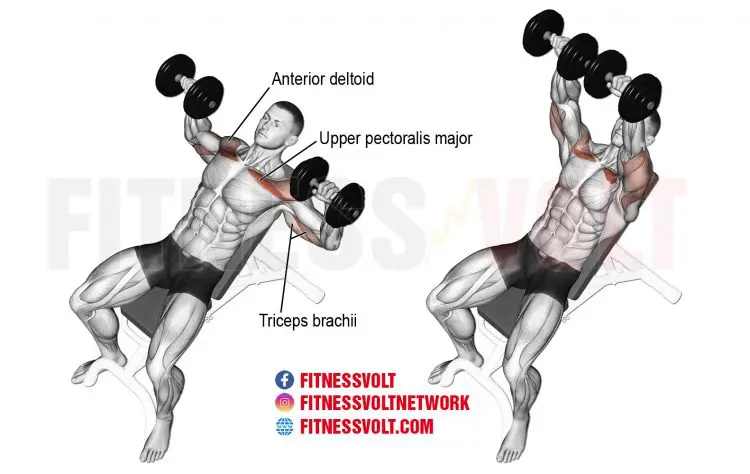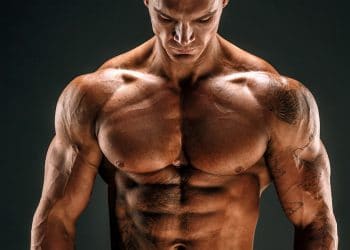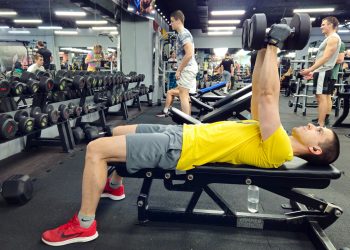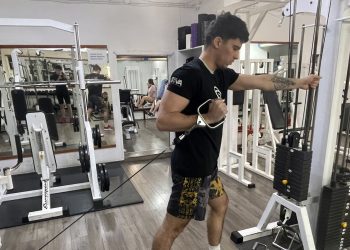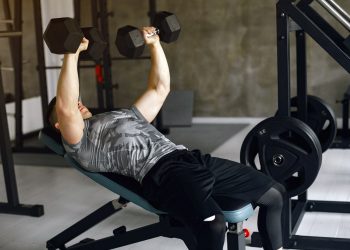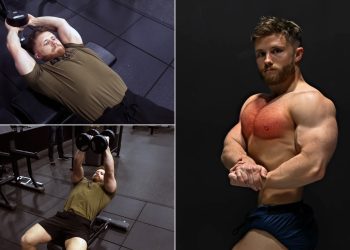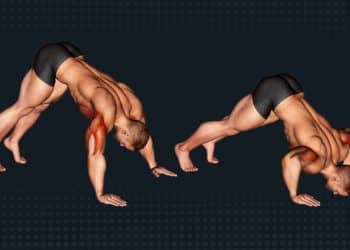The upper chest can be a stubborn muscle group and is often an underdeveloped area in many lifters. Furthermore, training upper pecs in isolation — without activating the rest of the muscle isn’t possible.
As a veteran personal trainer with over 35 years of experience, I have helped countless clients build a chest shelf that would make Arnold Schwarzenegger envious.
You can emphasize muscle recruitment near the clavicle area (located between the ribcage (sternum) and the shoulder blade (scapula) with the four upper chest workouts and training techniques detailed in this article.
An experienced lifter knows the importance of using different angles and techniques, especially for bigger muscle groups. Now, keep in mind that your genetics will determine how big and full your chest looks. But anyone (literally anyone) can make improvements and bring up weak points.
Recent Updates: On July 23, 2024, Fitness Volt’s Content Strategist Tom Miller (CSCS) and Senior Editor Vidur Saini (American Council on Exercise-CPT) updated the article and added actionable expert tips throughout the piece to improve the reader experience. Level Up Your Fitness: Join our 💪 strong community in Fitness Volt Newsletter. Get daily inspiration, expert-backed workouts, nutrition tips, the latest in strength sports, and the support you need to reach your goals. Subscribe for free!
14 Best Upper Chest Exercises
Here are the upper pec exercises you should add to your arsenal:
- Incline Dumbbell Press
- Single-Arm Low-To-High Cable Fly
- Pike Push-Up
- Incline Cable Crossover
- Jammer Press
- Landmine Press
- Incline Dumbbell Fly
- Dips
- Guillotine Press
- Incline Hammer Press Machine
- Incline Bench Press With Chains
- Incline Cable Bench Press
- Feet Elevated Archer Push-Up
- Swiss Bar Incline Press
1. Incline Dumbbell Press
| Sets & Reps | Equipment Needed | Target Muscles |
| 3 x 8-12 | Dumbbells | Upper pectoralis major |
The incline dumbbell press is part of our first upper chest workout. Why the incline dumbbell press? Isn’t it just an alternative to the incline barbell press?
It’s not just an alternative… In fact, the incline dumbbell press is preferred by many over the barbell version for a few reasons.
Using a barbell for the incline press can feel awkward and cause shoulder pain. That’s because when you’re at an incline, the bar path is usually near the upper or mid-chest. And when your shoulders are locked in, there isn’t as much room for the shoulder joint to move around as comfortably.
That’s why we like the incline dumbbell press. It allows your shoulders and arms a freer range of movement, and you can vary your hand position, which can ease the stress placed on the shoulders even more.
Incline chest exercises activate more of the front delts than the flat and decline bench press variations. To maximize chest activation and reduce delt dominance during incline presses, we recommend adjusting the bench to about a 30-degree angle.
This could also allow you to train heavier using dumbbells compared to a barbell while still maximizing chest engagement. Lastly, the adduction (bringing the arms toward the midline of the body) of the arms is an essential component of chest activation, which you can’t get by using a barbell.
Saini recommends driving through your heels and squeezing the glutes to create total body tension and increase pressing power.
How to do it:
- Set up a bench on an incline at between 30-45 degrees.
- Grab dumbbells in a neutral grip.
- Sit on the bench and rest the dumbbells on your thigh.
- Plant your feet on the ground and lift your chest up while keeping a slight arch in the back.
- Retract the shoulder blades and lie back to get into the position.
- Exhale, and press the dumbbells towards the ceiling.
- Slowly lower the dumbbells while inhaling. Feel the stretch in your pecs as you lower the dumbbells to the starting position.
- Complete at least 8-12 reps.
Pro Tip: Experience better contraction at the top by bringing your arms closer. Do not let the dumbbells touch at the lockout position; they should remain 1-to-2 inches apart.
Key benefits:
- It’s a fundamental chest exercise that will help your chest grow.
- It relieves excess stress from the shoulders.
| Difficulty | Progression | Regression |
| Beginner | Increase weight, add sets, decrease rest periods | Flat dumbbell press |
2. Single-Arm Low-to-High Cable Fly
| Sets & Reps | Equipment Needed | Target Muscles |
| 3 x 10-15 | Cable machine | Upper pectoralis major, serratus anterior |
Again, because the upper chest area is typically more underdeveloped, it’s a good idea to try and get as much adduction of the arms as possible for optimal muscle fiber activation.
But something many exercisers are unaware of is that the fibers of the upper chest run somewhat diagonally from the armpit up to the middle of the clavicle. Therefore, it’s smart to design an upper chest workout that allows you to follow the direction of the fibers.
Hence, it is the reason why we’re proposing a low-to-high cable fly using one arm at a time for a maximum squeeze. You can also go heavy with this exercise but focus on muscle contraction.
Bringing your arms low to high and across follows the upper chest fibers, as shown in the video.
How to do it:
- Set the cable pulley to the lowest position.
- Grab the D-handle bar with an underhand grip.
- Brace your core, and pull your chest up, bringing a little arch to your back.
- Step forward to get into the staggered stance while keeping a slight knee bend in the front leg.
- Keep your elbows slightly bent.
- Horizontally bring the working arm up to feel the squeeze in your upper chest.
Pro Tip: Initially, many lifters find it challenging to feel the muscle. Start with lightweight and high reps to warm up and establish a mind-muscle connection with that clavicular head.
Key benefits:
- Great isolation movement that enables you to work on the clavicular head individually.
- Doing single-arm low-to-high cable fly will eliminate muscle imbalance in your upper chest.
| Difficulty | Progression | Regression |
| Intermediate | Control eccentric (lowering) phase | Incline dumbbell fly |
3. Pike Push-Up
| Sets & Reps | Equipment Needed | Target Muscles |
| 3 x to failure | Bodyweight | Upper pectoralis major, anterior deltoids, triceps |
Pike push-ups are one of the most straightforward exercises for the upper chest that only require your body weight. But make no mistake, it’s still challenging for most people.
Another advantage is that it’s a closed-chain movement. This means your hands are fixed to an immovable surface (the ground), which engages more stabilizer muscles and forces your shoulders to prevent your body from moving in all directions. Movements like these make a good chest workout.
This is beneficial for overall upper body strength, stability, and performance.
To increase the difficulty of the pike push-up, elevate your feet up onto an object such as a box, chair, bench, etc.
How to do it:
- Get into the push-up position, and lift your hips up and back until you get into an inverted V position.
- Your feet and hands should be about three feet apart.
- Place your hands shoulder-width apart. Arms should be straight and elbows back.
- Bend your elbows to bring the body down to the floor.
- Hold for a second and then push back to get into starting position.
- Repeat 8-10 times.
Pro Tip: Use push-up handles if you want to experience a deeper stretch.
Key benefits:
- It strengthens your upper chest and shoulders.
- You don’t need a gym membership as it can be executed almost anywhere.
| Difficulty | Progression | Regression |
| Intermediate | Elevate feet, perform on unstable surface | Incline push-up |
4. Incline Cable Crossover
| Sets & Reps | Equipment Needed | Target Muscles |
| 3 x 12-15 | Cable machine | Upper pectoralis major |
Cables are great for keeping constant tension on a muscle, but you can also cross your arms for even more chest contraction, something you can’t do with a barbell or dumbbell.
Not to mention, the fly/crossover increases strength in the pecs and associated muscles since the arms are more outstretched and less stable when compared to a press.
Each rep should cross one arm over the other, alternating for each repetition.
How to do it:
Set-up: Place your bench directly in the center of the cable crossover machine.
- Set your bench at about 30-45 degree incline and the pulleys at the lowest setting.
- Grab the handles and lie down on the bench.
- Plant your feet on the ground and lift your chest up while keeping a slight arch in the back.
- Retract the shoulder blades and keep your elbows slightly bent.
- Exhale and contract your chest to bring both hands together.
- Inhale while slowly returning to the starting position.
Pro Tip: Concentrate on squeezing the contraction. Holding the contraction for two seconds will bring a better pump and upper-chest development.
Key benefits:
- Experience a superb pump in your upper chest.
- It’s a perfect upper chest isolation exercise.
| Difficulty | Progression | Regression |
| Beginner | Tempo reps | Incline dumbbell fly |
5. Jammer Press
| Sets & Reps | Equipment Needed | Target Muscles |
| 3 x 8-12 | Incline machine press | Upper pectoralis major, anterior deltoids, triceps |
You may have never heard of this movement before, but it’s one we absolutely recommend. By performing the exercise, you will emphasize your upper pecs and be able to do it more explosively. So if you’re an athlete or someone who desires to develop more power using your arms in an elevated position, then the jammer press is for you.
There are several ways to do this exercise. You could use a hammer strength machine, a landmine set-up, or even a suspended barbell rack.
Here’s an example although, you don’t have to press as explosively as what’s shown in the video:
How to do it:
- Grab the handles of an incline machine press with both hands.
- Lean forward and get on your tiptoes to bring explosiveness to the movement.
- Bend your knees to about 15-20 degrees.
- Brace your core.
- Exhale and explosively push the bar away until your arms are fully extended.
- Return to the starting position.
- Complete 8-10 reps.
Pro Tip: Utilize a staggered stance and ‘corkscrew’ your front foot into the ground to create a more stable base and drive more power through the movement.
Key benefits:
- It’s an excellent functional movement that activates fast-twitch muscle fibers.
- It brings explosiveness to the upper chest, shoulders, arms, core, glutes, and legs.
- Sports athletes widely use this variation to improve muscle coordination and athleticism.
| Difficulty | Progression | Regression |
| Advanced | Controlled negatives | Incline dumbbell bench press |
6. Landmine Press
| Sets & Reps | Equipment Needed | Target Muscles |
| 3 x 8-12 (each arm) | Barbell, landmine attachment | Upper pectoralis major, anterior deltoids, triceps |
Similar to the jammer press, the landmine press is a very effective upper chest exercise. You’ll secure one end of a barbell to the corner of a wall or use a dedicated landmine set-up made for this exercise.
The landmine press is also a great way to build explosive function in addition to size and strength. Not to mention, you can fully take advantage of arm adduction for optimal contraction and muscle recruitment.
You can do this exercise using one or two arms.
How to do it:
- Get on your knees.
- Grab one end of the barbell with both hands.
- Retract your shoulder blades while keeping the chest up.
- Lift the bar to your chest with your elbows in front of you.
- Brace your core while keeping your back straight and strong.
- Extend your arms while squeezing the pectoral muscles.
- Slowly bring the bar back to its starting position.
- Repeat for 10-12 reps
Pro Tip: Squeeze the contraction hard for two seconds.
Key benefits:
- Works wonderfully well to train upper-mid chest.
- It’s a functional exercise that strengthens front delts and improves muscle coordination.
| Difficulty | Progression | Regression |
| Beginner | Single-arm variation | Incline dumbbell press |
7. Incline Dumbbell Fly
| Sets & Reps | Equipment Needed | Target Muscles |
| 3 x 10-15 | Dumbbells | Upper pectoralis major |
It is one of the best exercises to develop a well-defined chest.
A well-designed training program should contain movements that train all the anatomical functions of the muscle, and for the pecs, this includes pressing and flying movements.
How to do it:
- Set up a bench at 30-45 degrees incline.
- Now grab a pair of dumbbells with a neutral grip.
- Lie down on the bench. Retract your scapula and plant your feet on the floor.
- Lower your arms towards the floor with a slight bend in the elbows.
- Lower until the dumbbells are at chest level.
- Feel the stretch in your chest.
- Hold for a second before returning to the starting position.
- Repeat for 8-12 reps.
Pro Tip: Focus on slow eccentrics and fast concentric motion.
Key benefits:
- Excellent chest isolation movement.
- It delivers the ‘chest separation’ that most people strive for.
| Difficulty | Progression | Regression |
| Beginner | Add sets, decrease rest periods | Incline dumbbell chest press |
8. Dips
| Sets & Reps | Equipment Needed | Target Muscles |
| 3 x to failure | Dip bars or assisted dip machine | Lower pectoralis major, triceps, anterior deltoids |
Some experienced lifters do not include dips in their upper chest workouts as they consider it a beginner exercise and would rather do partial reps on the machine chest press to stroke their egos.
If you are one of these individuals, you can make the exercise harder by performing weighted dips. Dips arguably have the biggest range of motion of any chest exercise and should be a staple in your pec training regimen.
How to do it:
- Grab the parallel bars and jump up to straighten your arms.
- Lean forward while you lower your body.
- Lower down till your elbows get into 90-degree flexion.
- Return to the starting position.
- Repeat for a few reps.
Pro Tip: Do not lock your elbows after every rep to maintain constant tension on your pecs. If you can comfortably do ten dips, it’s time to add resistance by wearing a weighted vest.
Key benefits:
- It’s a compound exercise that strengthens the chest, shoulders, and triceps.
- Regular dips may improve your bench press by strengthening your shoulders and triceps.
| Difficulty | Progression | Regression |
| Intermediate | Weighted dips | Assisted dips, incline push-ups |
9. Guillotine Press
| Sets & Reps | Equipment Needed | Target Muscles |
| 3 x 6-8 | Barbell | Upper pectoralis major |
The guillotine press is probably the weirdest-looking exercise on the upper chest workout program. To an untrained eye, the movement looks like a standard bench press performed incorrectly.
However, the guillotine press is an incredibly effective exercise for the upper chest as it provides an intense stretch in the clavicular pec head while limiting triceps engagement.
The guillotine press is performed with a barbell and includes lowering the bar to the neck (or even chin). Remember: Warm up your shoulders before performing the exercise, as the extreme elbow flare can put high stress on both heads of the pectoralis muscle.
How to do it:
- Setting up the guillotine press is the same as the straight bench press.
- Hold the bar slightly wider than shoulder-width apart. Flare your elbows wide.
- Lower the bar towards your neck until your elbows reach a 90-degree angle.
- Push the barbell up to the starting position.
- Complete a few reps before you rack the barbell.
Pro Tip: Control the tempo and practice slow and controlled sets.
Key benefits:
- This exercise results in extreme pec contraction.
- It’s an unconventional angle that effectively trains the upper chest area.
| Difficulty | Progression | Regression |
| Advanced | Tempo reps | Incline dumbbell press |
10. Incline Hammer Press Machine
| Sets & Reps | Equipment Needed | Target Muscles |
| 3 x 8-12 | Hammer Strength machine | Upper pectoralis major, triceps |
If you have trouble establishing a mind-muscle connection while performing upper chest workouts, you should add the incline hammer press machine to your exercise arsenal.
Here is how to perform the incline hammer press:
How to do it:
- Adjust the seat to position the handles at mid-chest level.
- Grab the handles with an overhand grip.
- Keep your chin up, chest high and core braced.
- Point your elbows down, close to the body.
- Exhale while pushing the handles out while fully extending your arms.
- Inhale while slowly bringing down the handles to the starting position.
- Repeat for a few reps.
Pro Tip: Training your upper chest on an incline hammer press machine is a great way to push through the limits, do some drop-sets to gain size and thickness in the upper chest.
Key benefits:
- Training on an incline hammer press machine is a safe upper chest strengthening option that does not require a spotter.
- One can also perform a unilateral version of this exercise.
- Training on a machine has always been favorable for beginners.
| Difficulty | Progression | Regression |
| Beginner | Add resistance bands | Incline dumbbell press |
11. Incline Bench Press with Chains
| Sets & Reps | Equipment Needed | Target Muscles |
| 3 x 6-8 | Barbell, chains, bench | Upper pectoralis major |
For anyone who has hit a plateau or wants to level up their chest training, it’s time to introduce chains to the incline bench press.
Introducing chains has great benefits; they induce variable resistance and increase muscle fiber recruitment.
Adding chains or resistance bands to the bench press helps develop explosive strength by improving force velocity.
How to do it:
- Get the chains with collars so you can attach them securely at both ends of the barbell.
- You must ensure the chain is touching the ground in the racked position.
- Touching the chain to touch the ground decreases the resistance as you lower the barbell towards your chest.
- Set the incline at a 30-degree angle and lie down on the bench.
- Grab the bar with a shoulder-wide overhand grip.
- Contract your chest and lift the bar up.
- Slowly bring the bar down to the chest, hold for a second and then quickly push it up.
Pro Tip: Make sure the movement is slow and controlled.
Key benefits:
- This movement helps build explosiveness.
- Chains wobble when you move the barbell up and down. Wobbling brings instability to the movement, leading to the recruitment of more muscle fibers to add stability.
- Develop a well-defined chest.
| Difficulty | Progression | Regression |
| Advanced | Paused reps | Incline dumbbell bench press |
12. Incline Cable Bench Press
| Sets & Reps | Equipment Needed | Target Muscles |
| 3 x 8-12 | Cable machine | Upper pectoralis major |
The incline cable bench press is a compound movement that targets the upper chest very efficiently.
Experienced lifters use this lift as a high-rep finisher. Also, it’s often used to challenge the muscle fibers from different angles by changing the pully position.
How to do it:
- Set up your incline bench exactly in the middle of a cable machine.
- Set the pulley at the lowest setting.
- Grab handles with both hands while positioning yourself on a bench for the incline bench press.
- Contract your shoulder blades in, lift the chest up and plant your feet.
- Extend your arms so they are perpendicular to the floor. Pause and contract your pecs at the top.
- Bring it down slowly while maintaining the posture.
- Repeat the process for more reps.
Pro Tip: Squeeze the handles at the top to feel more contraction and to enjoy a better pump.
Level Up Your Fitness: Join our 💪 strong community in Fitness Volt Newsletter. Get daily inspiration, expert-backed workouts, nutrition tips, the latest in strength sports, and the support you need to reach your goals. Subscribe for free!
Key benefits:
- Unlike dumbbells or barbells, cable flyes retain constant tension on the muscle fibers.
- Perform drop sets or super sets without a hassle.
| Difficulty | Progression | Regression |
| Beginner | Conventional bench press | Incline dumbbell press |
13. Feet Elevated Archer Push-Up
| Sets & Reps | Equipment Needed | Target Muscles |
| 3 x to failure | Bodyweight, elevated surface | Upper pectoralis major, triceps, anterior deltoids, serratus anterior |
For advanced lifters, doing a feet elevated push-up can be a piece of cake. Archer push-up is a great variation that strengthens the chest and eliminates muscle imbalance.
Archer push-up is an advanced variation of regular push-up that increases resistance by directing a higher percentage of your body weight to a single side.
How to do it:
- Get into a push-up position with your arms a little wider than shoulder width.
- Place your feet on a bench or any elevated surface.
- Maintain a strong core and keep your body in a straight line.
- Now bring your body down to the left side while straightening the other hand to assist the left hand.
- Push yourself up as you reach the bottom position or touch the floor.
- Now follow the same on the other side. Alternate between both sides.
Pro Tip: Keep your core tight during the whole movement, and don’t allow your body to rotate at one side.
Key benefits:
- It has significant strength benefits.
- Feet elevated archer push-up improves hypertrophy and muscle coordination.
| Difficulty | Progression | Regression |
| Advanced | Elevate further, pause at the bottom of the rep | Pike push-up |
14. Swiss Bar Incline Press
| Sets & Reps | Equipment Needed | Target Muscles |
| 3 x 8-12 | Swiss bar, bench | Upper pectoralis major |
If you want to strengthen improvements without messing up joint mobility, pressing with a Swiss bar is a great option you can choose.
The primary benefit of training with a Swiss bar is its ability to relieve stress from the wrist and shoulders, plus it improves tricep activation to support movement.
How to do it:
It’s just like a regular incline bench press; the bar allows you to try different grips at a neutral wrist position.
- Set up a bench at around 30 degrees incline.
- Grab the bar with a neutral grip at shoulder width.
- Keep your chest up, and core braced.
- Lift the bar up and complete a few reps of incline bench press.
Pro Tip: Try different grip variations to train the muscle fibers from different angles.
Key benefits:
- A neutral grip relieves pressure from the wrist and shoulders.
- It allows several grip variations.
- Builds bigger and stronger triceps.
| Difficulty | Progression | Regression |
| Beginner | Increase weight, add sets, decrease rest periods | Incline dumbbell press |
4 Best Upper Chest Workouts
Training the upper chest can be tricky. Although you might want to dedicate an entire session to an upper chest workout to bring up the lagging muscle group, it isn’t the most optimal way to approach pectoral training. Why is that, you ask?
Your upper chest is a relatively small muscle group, and performing five to six upper chest exercises in a training session will be nothing short of overkill. Devoting an entire workout to the upper pecs would be like doing five brachialis exercises in an arm workout in hopes of building thicker arms. You might see results, but you’ll be compromising on brachii and brachioradialis gains by sticking to neutral grip exercises.
To maximize your upper chest workout, perform at least three exercises on an incline bench to target the upper pecs. Also, perform two to three movements while standing (cable fly) or lying on a flat or declined bench.
Here are some of the most effective upper chest workouts you’ll ever do:
Upper Chest Workout #1
| Exercise | Sets | Reps | |
| 1 | Incline Barbell Bench Press | 3 sets | 10-12 reps |
| 2 | Incline Dumbbell Fly | 3 sets | 12-15 reps |
| 3 | Incline Dumbbell Press | 3 sets | 10-12 reps |
| 4 | Machine Chest Press | 3 sets | 10-12 reps |
| 5 | Pec Deck Fly | 3 sets | 10-12 reps |
| 6 | Dips | 3 sets | 15-20 reps |
You’ll be sticking to the basics in the first upper chest workout. It is a great workout to build a solid foundation. While performing dips, if you feel the exercise is too easy, add resistance by using additional weights.
Upper Chest Workout #2
| Exercise | Sets | Reps | |
| 1 | Incline Dumbbell Press | 3 sets | 10-12 reps |
| 2 | Single-Arm Low-to-High Cable Fly | 3 sets | 10-12 reps |
| 3 | Cable Crossover | 3 sets | 12-15 reps |
| 4 | Decline Dumbbell Press | 3 sets | 10-12 reps |
| 5 | Bench Press | 3 sets | 10-12 reps |
| 6 | Pike Push-up | 3 sets | 10-12 reps |
You’ll be starting and ending the second workout with upper chest exercises. The pike push-up is a great exercise to isolate your upper pecs and flush them with blood and lactic acid — to ignite new muscle growth — at the end of your chest workout.
Upper Chest Workout #3
| Exercise | Sets | Reps | |
| 1 | Smith Machine Incline Press | 3 sets | 10-12 reps |
| 2 | Incline Cable Crossover | 3 sets | 12-15 reps |
| 3 | Jammer Press | 3 sets | 10-12 reps |
| 4 | Landmine Press | 3 sets | 10-12 reps |
| 5 | Dumbbell Floor Press | 3 sets | 10-12 reps |
| 6 | Decline Dumbbell Press | 3 sets | 10-12 reps |
The Smith machine is one of the most underutilized chest training tools. It can help you focus on your upper pec stimulation by stabilizing the weight, fixing your range of motion, and improving your form.
So you’ve never heard of the jammer and landmine press before? Don’t worry. Head over to the next section to learn about them in detail.
Upper Chest Workout #4
| Exercise | Sets | Reps | |
| 1 | Guillotine Press | 5 sets | 10-12 reps |
| 2 | Incline Hex Press | 5 sets | 10-12 reps |
| 3 | Incline Hammer Press Machine | 5 sets | 10-12 reps |
| 4 | Dumbbell Pullover | 5 sets | 10-12 reps |
| 5 | Decline Push-up | 5 sets | 10-12 reps |
The last upper chest workout on the list is a high-intensity, high-volume session. You will perform 25 sets and should be running on fumes by the end of the workout.
Chest Anatomy
Understanding your chest anatomy will help you understand muscle engagement while training.
The pectoral muscles are responsible for the pushing movement. They consist of four muscles: the pectoralis major, pectoralis minor, serratus anterior, and subclavius.
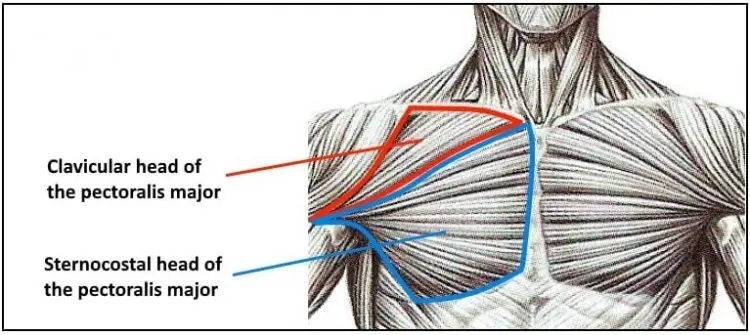
Pectoralis major:
When you think about a well-built chest, the pectoralis major is the primary muscle you are thinking of. The pectoralis major is the most superficial pectoral muscle that adds size to the chest.
The pectoralis major is the large muscle that is divided into two muscles: the clavicular head and the sternocostal head.
- Clavicular head: It got its name because it originates from the anterior surface of the medial clavicle (collarbone) and comprises the upper part of the pectoralis major. The clavicular head is also referred to as the upper chest.
- Sternocostal head: It comprises the mid and lower portion of the pectoralis major. It’s called the sternal head because it originates from the anterior surface of the sternum. The sternocostal head accounts for about 75 percent of the total volume of the pectoralis major.
Pectoralis minor:
The pectoralis minor is a deep muscle that lies underneath the pectoralis major. Fibers of pectoralis minor attach the ribs to the shoulder. The primary function of pectoralis minor is stabilizing the scapula by drawing it anteroinferiorly.
Do you neglect the importance of training pectoralis minor because it does not add visible results? By volume, the pectoralis minor is almost equal to the size of your biceps muscles. Therefore, it can add significant volume and size to the chest by pushing the pectoral major outwards. Chest dips and cable flies can strengthen the pec minor.
Serratus anterior:
The serratus anterior is located more laterally in the chest wall and attaches to the scapula for stability. This muscle consists of several strips, each attached to lateral aspects of ribs 1-8. The other end of the serratus anterior is attached to the medial border of the scapula.
The primary function of the serratus anterior is to support pressing movement (vertical or horizontal) by stabilizing the scapula for optimum scapular protraction, shoulder abduction, and upward rotation. A dumbbell pullover is a great exercise to train the serratus anterior.
Upper Chest Training Variables
Understanding the different training variables can help optimize performance; train your muscles differently by introducing minor tweaks in the training style to stimulate muscle growth.
Trying different rep ranges, intensities, and body positioning can help you determine what works best for you. Experienced lifters comprehend training outcomes by changing angles, intensity, and body positioning.
Effects of different angles:
The angle at which you are training your muscles plays a crucial role in determining exercise efficiency.
Sometimes, lifters do not see the signs of muscle development just because they are not training those muscles at optimal angles.
In a 2020 study, researchers found that the middle and lower part of the pectoralis major had maximum activation when they set the bench at 0 degrees (flat). The upper chest got maximum activation when the bench was set at 30 degrees, and anterior deltoids (front shoulders) had maximum resistance when the bench was set at a 60-degree angle. [1]
Researchers also stated that anterior delts start to take over the lift when the bench is set more than 45 degrees.
Workout tempo:
A 2021 research paper on “Influence of movement tempo during resistance training on muscular strength and hypertrophy” states: “it seems that the most favorable is a combination of slower eccentric movements, paired with faster concentric movements.”
Concentrating on the negative reps (eccentric movement) certainly helps you maximize muscle and strength gains. [2]
Rep-ranges:
Chest comprises about 60% fast-twitch muscle fibers and 40% slow-twitch muscle fibers.
Fast twitch muscle fibers are activated when you train between the 6-12 rep range. High-intensity training stimulates fast-twitch muscle fibers.
You can’t leave your slow-twitch muscle fibers untrained; train between the rep range of 12-20 to target slow-twitch muscles.
Switch the rep ranges from low to medium to high to stimulate muscle growth of both types of muscle fibers.
Grip optimization:
Wide grips usually shift the stress from the upper chest to the mid chest.
How do you position your grip while training your upper chest? A shoulder-width grip will ensure better upper chest activation when doing a barbell chest press.
Warm-Up And Chest Activation
Most injuries happen when the muscle is not prepared to handle heavy loads.
We all know that warm-up is crucial before training. Still, many lifters do their warm-up wrong. When we say “warm up,” we don’t mean 15 reps of bench press with an empty barbell or 10 minutes of jogging.
Warm-up is about getting the blood flowing into the target muscles and waking up the muscle fibers that are about to experience intense stress. A good warm-up session should prepare the muscles and joints for resistance training.
How to warm up before a chest session?
A good warm-up routine should activate and prepare the primary and stabilizer muscles before training.
Plyo pushups: A few warm-up sets of plyo pushups activate fast-twitch muscles, ultimately improving the ability to lift heavier objects.
Plyo pushups prepare the pectoral muscle to enhance the power output by recruiting more muscle fibers.
Sets of dips: Dips are great for activating shoulders and triceps. These are the primary stabilizer muscle that boosts your pushing ability.
Cable face pulls: This exercise activates rear delts and scapula. The scapula plays a significant role in stabilizing your shoulders during a heavy bench press. Rear delt and scapula activation reduces the chances of injuries and adds stability.
Plank: “Brace your core while bench press,” you must have heard this many times from the trainer or instructor. What are you doing to keep your core tight?
Doing two to three sets of bodyweight planks can drastically improve your core activation; this indeed helps pressing performance.
How To Make Most of Your Upper Chest Workout
Below are a few tips to make the most of your upper pec workouts:
1. Follow a Full Range of Motion
Research suggests that going through a full range of motion (ROM) results in better muscle balance, joint stability, proper activation of the working muscles, and overall better movement quality. Additionally, following a full ROM can reduce your chances of injury while performing an exercise. [3]
While performing the pressing movements in your upper chest workout, your arms should be fully extended, and your elbows almost locked out at the top. On the other hand, the barbell will be a few inches away from your chest at the bottom.
2. Use Advanced Training Techniques
According to a study, using advanced training techniques like accentuated eccentric loading can help lead to greater strength gains for experienced lifters and avoid hitting a plateau. [4]
Besides, following the same training routine repeatedly can become redundant, which can further lead to a loss of motivation. Incorporating advanced training principles like supersets, drop sets, intraset stretching, and blood flow restriction (BFR) in your upper chest workout can take your pectoral gains to the next level.
3. Mind-Muscle Connection
Why is a mind-muscle connection so important, you ask? Per a study, a mind-muscle connection allows you to focus your effort on a specific muscle, which can help improve your workout intensity and performance. [5]
If you have trouble establishing a mind-muscle connection while performing the upper pec workout, you should try dropping the weights and slowing down your rep tempo. You could also pause at the top and bottom of the movement to maximize muscle contraction.
Practicing dynamic warm-up and muscle activation drills also considerably improves the muscle pump and lifting performance.
4. Add Variety To Your Workouts, But Not Too Much
While it is important to keep switching your exercises to avoid hitting a rut, many lifters make the mistake of changing their training regimen way too often. To get the best bang for your buck, you should stick to a workout regimen for at least three to four weeks.
Tips To Improve Pressing Strength
Let’s look at some practical tips that professional lifters use to enhance their strength.
Skip static stretching
A static stretch is when you stretch the muscle and hold the position for 30-45 seconds.
Static stretches are excellent for relieving post-workout muscle stiffness and soreness, but they do more harm when included in a pre-workout routine.
Static stretching before a workout elongates the muscle fibers and tendons, reducing their natural elasticity and negatively impacting lifting performance.
Include chains and band
Including chains or bands in your strength training can provide tremendous benefits to your lifting abilities.
How do chains and bands help? They both work on the principle of “variable resistance training,” which means variable changes at a different range of motion.
For example, a band’s resistance is zero at the starting position and increases as the band is strained.
Most lifters are weakest at the bottom of the bench press and strongest near the top. Introducing bands or chains reduces the tension at the bottom of the lift and improves muscle contraction by increasing the resistance at the peak contraction.
Emphasize unilateral training
You should include at least 1-2 unilateral exercises in each workout session. Training unilaterally has many benefits, including rectifying muscle imbalance, building a stronger core, and lowering the chances of injuries.
Strengthen your weak points
The quality of your bench press does not solely depend on your pectoral muscles; it also depends on supporting muscle groups.
The bench press involves the pecs, front delts, scapula, triceps, forearm, and grip. Weakness in any supporting muscle can limit your ability to deliver your max. Pay attention to the weak links and work on them.
Focus on making small gains
Start a workout journal to track your progress. Focus on making small gains by gradually increasing the number of weight or total reps. You will start noticing improvement in lifting performance.
Instead of prioritizing big wins, concentrate on training better than the previous session. Bodybuilding is not a short-term process; it will test your patience.
Nutrition
One can not neglect the importance of nutrition for optimum performance.
Pre-workout meal: Many lifters place too much emphasis on the post-workout meal but neglect the importance of the pre-workout meal. Your pre-workout meal will fuel your training session, so it should be designed according to the training goals.
An ideal pre-workout meal should contain:
- Fast digesting carbs: Ingestion of fast-digesting carbs will replenish the muscle glycogen levels.
- Slow-digesting carbs: While training, the muscle loses its glycogen reserves rapidly; ingestion of slow-digesting carbs will refill those muscle glycogen.
- Protein: For recovery and to prevent muscle catabolization.
Post-workout meal: Eat to recover fast. Eat fast-digesting carbs to initiate the recovery process and some lean protein for muscle repair.
Warm Up Your Chest Before Training
Now that you know everything there is to know about building a Superman-like chest, you shouldn’t try to hit a PR on your first working set. “Bench presser’s shoulders” are real and are a certainty if you do not spend 5-10 minutes warming up your shoulders and pecs before an upper chest workout.
You should perform a dynamic warm-up routine before every workout to minimize the chances of injury while optimizing your performance inside the weight room.
A dynamic warm-up routine focuses on loosening muscle fibers, lubricating joints, and improving range of motion, which can improve speed, agility, and acceleration.
If you’ve never performed a resistance-training-specific warm-up routine before, do not fret. Here is an exhaustive loosening-up routine that will get you ready for the hardest of workouts — Upper Body Warm-Up You Should Be Doing Before Every Workout.
Wrapping Up
By doing these unique and extremely effective upper chest workouts, you can benefit from more size, strength, and overall development.
We literally hand-picked these movements to offer you the best options possible. Of course, these exercises aren’t the only ones you can or should do, but each does have its own advantage. So, combine them and get your pecs that pop!
References
- Rodríguez-Ridao D, Antequera-Vique JA, Martín-Fuentes I, Muyor JM. Effect of Five Bench Inclinations on the Electromyographic Activity of the Pectoralis Major, Anterior Deltoid, and Triceps Brachii during the Bench Press Exercise. Int J Environ Res Public Health. 2020 Oct; 17(19): 7339. doi: 10.3390/ijerph17197339. PMID: 33049982.
- Wilk M, Zajac A, and Tufano JJ. The Influence of Movement Tempo During Resistance Training on Muscular Strength and Hypertrophy Responses: A Review. Sports Med. 2021; 51(8): 1629–1650. doi: 10.1007/s40279-021-01465-2. PMID: 34043184.
- Schoenfeld BJ, Grgic J. Effects of range of motion on muscle development during resistance training interventions: A systematic review. SAGE Open Medicine. 2020;8:205031212090155.
- Simon Walker, Anthony J. Blazevich, G. Gregory Haff, James J. Tufano, Robert U. Newton, Keijo Häkkinen. Greater Strength Gains after Training with Accentuated Eccentric than Traditional Isoinertial Loads in Already Strength-Trained Men. Frontiers in Physiology, 2016; 7 DOI: 10.3389/fphys.2016.00149.
- Calatayud J, Vinstrup J, Jakobsen MD, Sundstrup E, Brandt M, Jay K, Colado JC, Andersen LL. Importance of mind-muscle connection during progressive resistance training. Eur J Appl Physiol. 2016 Mar;116(3):527-33. doi: 10.1007/s00421-015-3305-7. Epub 2015 Dec 23. PMID: 26700744.

